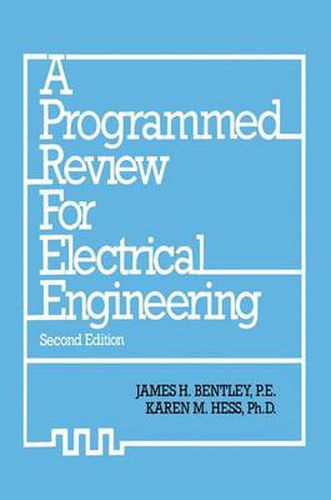Readings Newsletter
Become a Readings Member to make your shopping experience even easier.
Sign in or sign up for free!
You’re not far away from qualifying for FREE standard shipping within Australia
You’ve qualified for FREE standard shipping within Australia
The cart is loading…






This title is printed to order. This book may have been self-published. If so, we cannot guarantee the quality of the content. In the main most books will have gone through the editing process however some may not. We therefore suggest that you be aware of this before ordering this book. If in doubt check either the author or publisher’s details as we are unable to accept any returns unless they are faulty. Please contact us if you have any questions.
The field of electrical engineering is very innovative-new products and new ideas are continu ally being developed. Yet all these innovations are based on the fundamental principles of electrical engineering: Ohm’s law, Kirchhoff’s laws, feedback control, waveforms, capacitance, resistance, inductance, electricity, magnetism, current, voltage, power, energy. It is these basic fundamentals which are tested for in the Professional Engineering Examination (PE Exam). This text provides an organized review of the basic electrical engineering fundamentals. It is an outgrowth of an electrical engineering refresher course taught by the author to candidates preparing for the Professional Engineering Examination-a course which has enabled scores of electrical engineers in Minnesota and Wisconsin to successfully pass the PE Exam. The material is representative of the type of questions appearing in the PE Exams prepared by the National Council of Engineering Examiners (NCEE) over the past twelve years. Each problem in the text has been carefully selected to illustrate a specific concept. Included with each problem is at least one solution. Although the solutions have been carefully checked, both by the author and by students, there may be differences of interpretation. Also, in some cases certain assumptions may need to be made prior to problem solution, and since these to individual, the final answer may also differ. The assumptions will vary from individual author has attempted to keep the requirements for assumptions and interpretation to a mini mum.
$9.00 standard shipping within Australia
FREE standard shipping within Australia for orders over $100.00
Express & International shipping calculated at checkout
This title is printed to order. This book may have been self-published. If so, we cannot guarantee the quality of the content. In the main most books will have gone through the editing process however some may not. We therefore suggest that you be aware of this before ordering this book. If in doubt check either the author or publisher’s details as we are unable to accept any returns unless they are faulty. Please contact us if you have any questions.
The field of electrical engineering is very innovative-new products and new ideas are continu ally being developed. Yet all these innovations are based on the fundamental principles of electrical engineering: Ohm’s law, Kirchhoff’s laws, feedback control, waveforms, capacitance, resistance, inductance, electricity, magnetism, current, voltage, power, energy. It is these basic fundamentals which are tested for in the Professional Engineering Examination (PE Exam). This text provides an organized review of the basic electrical engineering fundamentals. It is an outgrowth of an electrical engineering refresher course taught by the author to candidates preparing for the Professional Engineering Examination-a course which has enabled scores of electrical engineers in Minnesota and Wisconsin to successfully pass the PE Exam. The material is representative of the type of questions appearing in the PE Exams prepared by the National Council of Engineering Examiners (NCEE) over the past twelve years. Each problem in the text has been carefully selected to illustrate a specific concept. Included with each problem is at least one solution. Although the solutions have been carefully checked, both by the author and by students, there may be differences of interpretation. Also, in some cases certain assumptions may need to be made prior to problem solution, and since these to individual, the final answer may also differ. The assumptions will vary from individual author has attempted to keep the requirements for assumptions and interpretation to a mini mum.